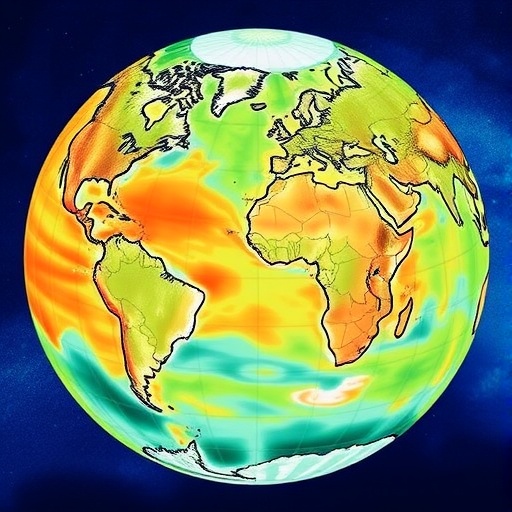In a groundbreaking study poised to reshape our understanding of global mercury cycling, researchers have harnessed advanced isotopic modeling to precisely trace the atmospheric sources of mercury entering the world’s oceans. Mercury, a potent neurotoxin that poses significant environmental and human health risks, circulates globally through complex pathways involving the atmosphere, terrestrial ecosystems, and aquatic systems. Yet, until now, the relative contributions of atmospheric mercury to oceanic mercury inventories remained uncertain, hindering efforts to mitigate its ecological and toxicological impacts effectively.
The international team, led by Song, Huang, and Wang, combined an innovative isotopic approach with oceanographic and atmospheric data to build a robust model that disentangles the atmospheric mercury sources feeding into the marine environment. Their findings, recently published in Nature Communications, highlight the nuanced interplay between natural emissions, anthropogenic activities, and atmospheric chemical transformations in seeding mercury into the ocean.
Mercury exists in multiple chemical forms in the atmosphere, including elemental mercury (Hg^0), reactive gaseous mercury (RGM), and particulate-bound mercury (PHg). Each species exhibits distinct atmospheric lifetimes and deposition behaviors, complicating source identification when mercury ultimately enters marine systems. To overcome this, the authors deployed a high-resolution isotopic characterization method, leveraging both mass-dependent and mass-independent fractionation signatures of mercury isotopes. These isotopic fingerprints allow differentiation between mercury emissions originating from coal combustion, artisanal gold mining, volcanic outgassing, and re-emission from terrestrial surfaces.
Using extensive sampling campaigns across diverse marine regions, the study integrated isotopic data from atmospheric deposition collectors, seawater samples, and sediment cores. The model quantitatively constrained the contributions from primary anthropogenic sources—chiefly fossil fuel combustion and industrial processes—and from secondary re-emission sources, wherein mercury previously deposited to land or ocean surfaces re-enters the atmosphere. Notably, the research illuminated the pivotal role of atmospheric transport pathways in redistributing mercury globally, with prevailing wind patterns influencing deposition hotspots even in remote oceanic zones.
One of the most striking findings relates to the differential deposition dynamics of speciated mercury. Elemental mercury, due to its long atmospheric lifetime and volatility, was shown to be transported across hemispheres before being oxidized and settling into ocean water. Reactive gaseous mercury, conversely, exhibited more localized deposition patterns due to its higher water solubility and shorter atmospheric residence time. This distinction underscores the need for air quality and climate policies to consider speciated mercury chemistry when targeting emission reductions.
The isotopic model also revealed temporal variability in mercury sources influenced by seasonal atmospheric circulation changes and episodic emission events, such as biomass burning and volcanic eruptions. For instance, the researchers detected episodic pulses of volcanogenic mercury signatures in marine sediments corresponding to documented eruptive events, confirming atmospheric deposition as a critical vector for these natural emissions to reach the ocean floor.
In tandem with understanding sources, the study sheds light on mercury cycling processes within the ocean itself. The interaction between dissolved mercury species and biogeochemical cycles modulates mercury bioavailability and methylation—the conversion to methylmercury, a highly toxic neurotoxin that bioaccumulates in marine food webs. By constraining the atmospheric mercury input, the research provides a more accurate baseline to evaluate methylmercury production in coastal and open ocean systems, informing risk assessments for fisheries and human seafood consumers.
The employment of isotopic tracers represents a methodological leap forward in mercury science. Traditional concentration measurements could not resolve the complex mixture of sources and transformations, often leading to ambiguous conclusions. Through isotope geochemistry, this study delivers a high-resolution, quantitative partitioning of mercury origins, applicable to other global biogeochemical cycles where source attribution remains elusive.
This quantitative source attribution for atmospheric mercury to the ocean has profound implications for environmental management and policy frameworks aimed at mercury pollution control. The findings reinforce the critical necessity of reducing anthropogenic emissions globally, particularly in emerging economies where industrial expansion continues to drive mercury release. Moreover, the research advocates for integrated monitoring programs combining isotopic analysis with continuous atmospheric and marine observations to track mercury’s evolving distribution amid climate change.
Given mercury’s propensity to bioaccumulate and biomagnify in marine ecosystems, affecting apex predators and ultimately human populations, precision in source identification enhances the predictive power of ecosystem health models. The enhanced understanding of atmospheric mercury deposition pathways provides a scientific foundation to refine international agreements such as the Minamata Convention on Mercury, facilitating evidence-based policy interventions and targeted emission controls.
Furthermore, this study highlights the interconnectedness of atmospheric chemistry, oceanography, and environmental toxicology, emphasizing the need for multidisciplinary approaches. Advances in isotope ratio mass spectrometry and atmospheric transport modeling underpin this research, showcasing how cutting-edge analytical technologies can unlock previously inaccessible environmental insights.
In conclusion, the isotopic model developed by Song and colleagues marks a watershed moment in mercury research, offering unparalleled clarity in tracing atmospheric mercury’s journey to the ocean. Its intricate analysis delineates the contributions from natural versus anthropogenic sources, captures spatial and temporal dynamics of mercury deposition, and deepens our grasp of mercury’s marine cycling. As mercury remains a formidable environmental threat, this work equips scientists, policymakers, and stakeholders with critical knowledge to forge more effective strategies for minimizing mercury’s global impact.
The study’s implications extend beyond mercury alone, setting a precedent for isotope-based source attribution in tracking pollutants that traverse diverse spheres of the Earth system. By elucidating complex source-receptor relationships, such research informs a new generation of environmental stewardship that is both scientifically rigorous and globally coordinated. As humanity grapples with persistent and emerging contaminants, the methodologies refined here will play a pivotal role in safeguarding ocean health and public well-being for generations to come.
Subject of Research: Atmospheric sources of mercury to the ocean constrained by isotopic modeling
Article Title: Atmospheric source of mercury to the ocean constrained by isotopic model
Article References:
Song, Z., Huang, S., Wang, Y. et al. Atmospheric source of mercury to the ocean constrained by isotopic model.
Nat Commun 16, 5752 (2025). https://doi.org/10.1038/s41467-025-60981-1
Image Credits: AI Generated




